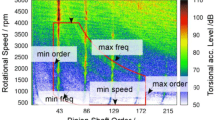Abstract
Due to generally reducing the noise level of machines and automotive applications gear noise optimization becomes more important. To optimize the excitation of the gearing in the development process, tooth contact analysis software is used. The transmission error is most common to characterize the noise excitation of gear sets. Usually in automotive applications gear noise is influenced by the entire drive train system with all its components. Therefore, it is necessary to asses if the transmission error of the gear set correlates to the noise of the drive train. Aim of a project funded by the German Research Foundation (DFG) was to investigate the possibility to measure the transmission error for every step of assembly. The transmission error was measured for a gear set, the transmission and the drive train. The research object was the drive train of a light truck. This report presents the results of the completed project.









Similar content being viewed by others
References
Brecher C, Gorgels C, Hesse J (2008) Development of a flexible concept for direct determination of the excitation in manual transmissions, 7th international CTI symposium, innovative automotive transmissions vol 2, pp 713–731
Brecher C, Gorgels C, Ingeli J (2010) Verwendung der FE-basierten Zahnkontaktanalyse zur Analyse asymmetrischer Verzahnungen, KT2010, 8. Gemeinsames Kolloquium Konstruktionstechnik, pp 41–46
Brecher C, Gorgels C, Hesse J (2009) Untersuchung des dynamischen Verhaltens flankenoptimierter Radsätze im Gesamtsystem Antriebsstrang, Haus der Technik—Systemanalyse in der Kfz-Antriebstechnik V, pp 142–157
Klocke F, Gorgels C, Vasiliou V (2009) Analysis of the influence of gear dimensions on cutting speed and contact conditions during the gear honing process. Prod Eng Res Dev 3(3):255–259
Patel K, Batish A, Bhattacharya A (2009) Optimization of surface roughness in an end-milling operation using nested experimental design. Prod Eng Res Dev 3(4–5):361–373
Klingelnberg J (2008) Kegelräder—Grundlagen, Anwendungen. Springer, Berlin
Norm DIN 3960 (1987) Begriffe und Bestimmungsgrößen für Stirnradpaare (Zylinderräder) und (Zylinderpaare) mit Evolventenverzahnung. Beuth Verlag, Berlin
Norm ISO 17485 (2006) Kegelräder—ISO-Toleranz-system. Beuth Verlag, Berlin
Richtlinie VDI 2608 (2001) Einflanken- und Zweiflanken-Wälzprüfung an Zylinderrädern, Kegelrädern, Schnecken und Schneckenrädern. Beuth Verlag, Berlin
Abele E, Rothenbücher S, Weigold M (2008) Cartesian compliance model for industrial robots using virtual joints. Prod Eng Res Dev 2(3):339–343
Acknowledgments
The research presented in this paper was founded by the German Research Foundation (DFG). We also thank GETRAG and Visteon for provisioning gears and transmissions.
Author information
Authors and Affiliations
Corresponding author
Rights and permissions
About this article
Cite this article
Brecher, C., Gorgels, C., Hesse, J. et al. Dynamic transmission error measurements of a drive train. Prod. Eng. Res. Devel. 5, 321–327 (2011). https://doi.org/10.1007/s11740-011-0310-5
Received:
Accepted:
Published:
Issue Date:
DOI: https://doi.org/10.1007/s11740-011-0310-5




